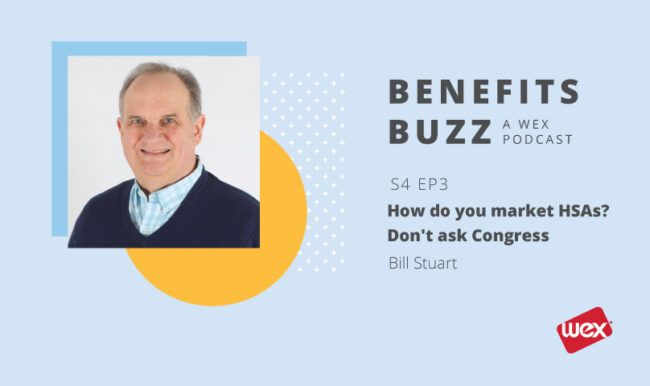Stay connected
Subscribe to our health benefits blog and follow us on social media to receive all our health benefits industry insights.

To contribute to a health savings account (HSA), participants must be enrolled in an HSA-eligible health plan. One of the requirements for an HSA-eligible health plan is that the health plan meets the IRS’ deductible limit. The phrase “high-deductible health plan” is synonymous with these plans, but referring to them as such also overshadows the perks of being enrolled in one.
“Congress … they’re very poor marketers,” said Bill Stuart, who is now the director of planning and business analysis at Voya. “You would not call it a high-deductible health plan. You’d call it a low-premium plan. You’d call it an HSA-qualified plan. A tax-savings plan. You wouldn’t call it a high-deductible health plan.”
Stuart joined us on our most recent episode of Benefits to break down some common myths about HDHPs/HSA-eligible health plans. Watch the episode below, or keep reading to learn three myths he outlined regarding these plans.
If a participant’s deductibles are high, it’s not because of the HSA. Deductibles are tied to health plans, while HSAs are savings accounts paired with health plans to help participants save money.
“An HSA is a financial account. It’s an account that helps you pay expenses,” Stuart said. “The medical plan may have a high deductible. … The HSA itself is helping you pay those expenses.”
Even if you’re evaluating how high a health plan’s deductible is, the average deductible for a traditional health plan isn’t that much different than an HDHP’s IRS limit. In 2018, the average deductible for a traditional plan was $932 for single and $1,931 for family. The 2021 HDHP limits are $1,400 and $2,800, respectively.
Because an HSA requires plans with higher deductibles, there’s a perception that only wealthier individuals (who are more likely to afford these deductibles) benefit from HSAs. However, the tax savings and retirement-planning potential of an HSA can benefit anyone eligible.
“There’s a lot of data in the industry that shows the average household income for a health FSA (flexible spending account) versus a health savings account is practically the same,” Stuart said. “It’s not income. It’s not the amount of medical claims. It’s not general health. The biggest factor in determining whether you have one or the other is simply what your employer offers.”
The higher deductibles with HSA-eligible health plans also leave many thinking that these plans and their HSA partners are only for the healthy.
HSAs can help cover a number of chronic health conditions, thanks in part to a guidance issued by the IRS and the U.S. Department of the Treasury in 2019. IRS Notice 2019-45 stated that, starting in 2020, certain expenses for care of chronic conditions are considered preventative for participants enrolled in HDHPs and HSAs. These additional expenses are eligible to be covered by insurance, even before participants reach their required HSA deductible.
Stuart also points out that comparing the out-of-pocket maximum to what you would find with the Affordable Care Act (ACA) may surprise you.
“The criticism early on was that they’re for the healthy and wealthy and wise,” Stuart said. “Originally, they probably were. But now that more employers are offering, less healthy people are going into it. Sometimes, even when you have a chronic condition, the out-of-pocket maximum on a health savings account program is actually lower than the affordable care act (ACA) maximum.”
Would you like to get more insight from Stuart? Connect with him on LinkedIn or check out the Benefit Strategies blog. Stuart has also written “HSAs: The Tax-Perfect Retirement Account,” which is available for purchase.
Would you like to learn more about HSAs and retirement planning? Get your free white paper.
The information in this blog post is for educational purposes only. It is not legal or tax advice. For legal or tax advice, you should consult your own counsel.
Subscribe to our health benefits blog and follow us on social media to receive all our health benefits industry insights.